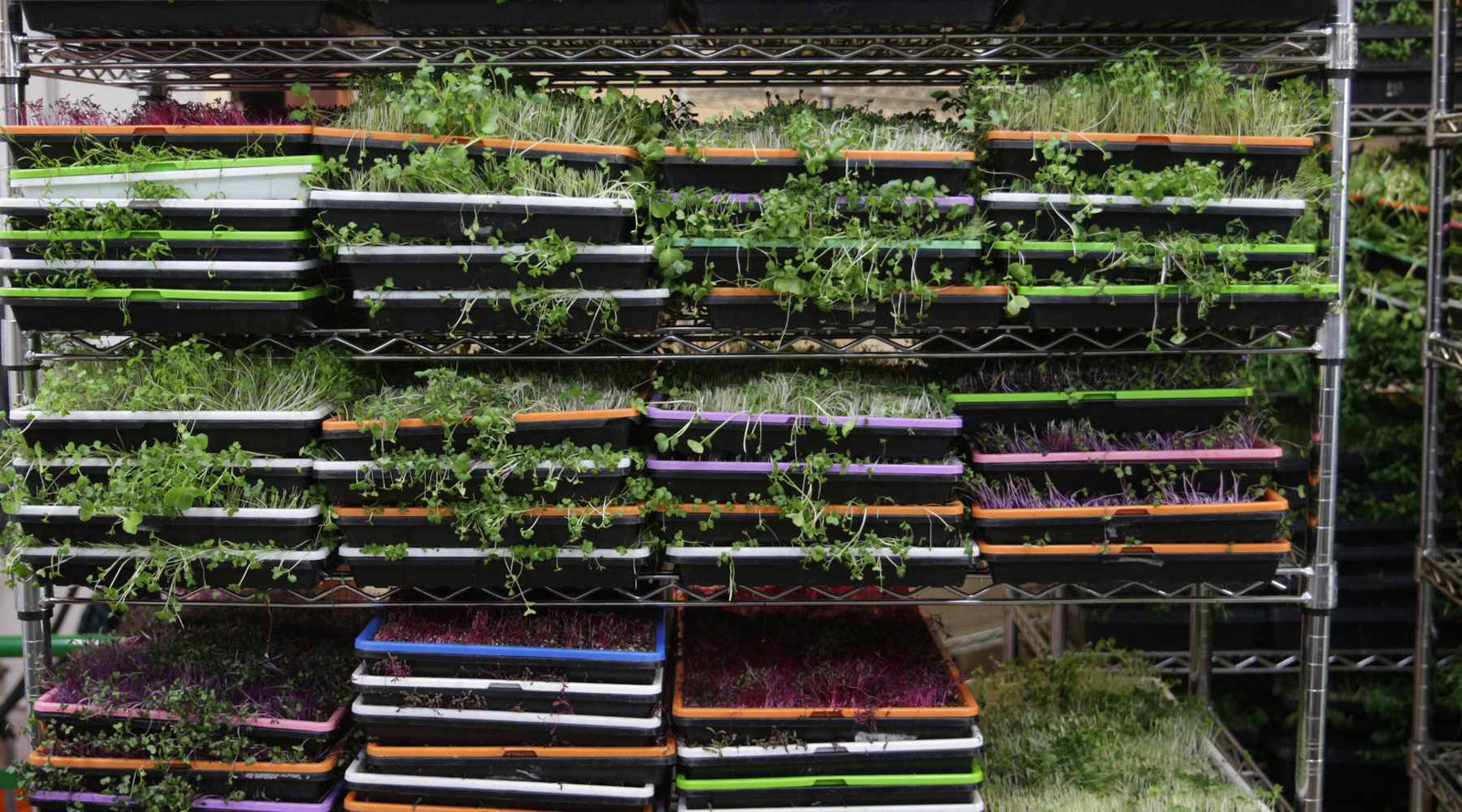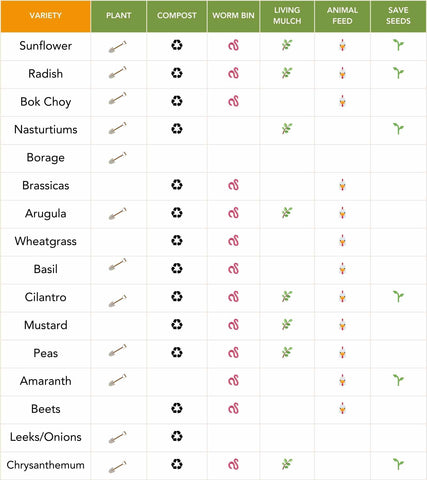Free Shipping on Orders over $75 to the Contiguous US
Free Shipping on Orders over $75 to the Contiguous US
Reusing Spent Trays of Cut Microgreens
March 05, 2024 4 min read 0 Comments

Reusing Soil After Harvesting Microgreens
After your microgreens are cut, what do you do with the spent tray? The leftover roots, stems, and growing media can be used to augment your growing or homesteading efforts in a number of ways.
Can You Reuse Microgreen Growing Medium?
Reusing growing media to grow another tray of microgreens immediately after harvest is a bad idea. Spent growing media is far more likely to harbor pests and fungal diseases than fresh media. Also, as the roots and cut stems begin to break down, they will rot, attract fungus gnats, and grow mold. However, you can still compost, generate worm castings to feed outdoor plants, and use the residual root mats and plant matter in other ways.
In some areas, regulations may limit how much material you can compost at a time. It is a good idea to check your local regulations to see if you need to be inspected or have a license to compost and reuse growing media on your farm.
Ways to Reuse Spent Microgreen Trays.
Microgreens trays grown using growing mediums such as hemp, soil, coco coir, and other growing mediums can all be composted or vermicomposted. They can also be used as living mulch, planted in the garden, used for seed-saving, or fed to livestock.
How to use spent trays of microgreens

Planting Flowers Out of Spent Microgreen Trays
Nasturtiums, borage, and chrysanthemum greens can be planted directly into garden beds or grow bags and allowed to grow. They produce edible flowers quickly and can provide an additional product for sale. A 1020 tray of nasturtiums planted in a larger pot or garden bed can start producing flowers in as little as 4 weeks.
Radish and bok choy trays planted in the garden will produce full-size veggies in 4-6 weeks.

Using Spent Microgreen Trays as Living Mulch
Much like straw, the thick root mats generated by microgreens help the soil underneath retain moisture and nutrients when used as mulch. Microgreens grown on hemp mats make especially good mulch. The presence of decaying roots and the protected soil surface draw worms and beneficial microbes upward. Hemp mats are especially great for living mulch.
This reduces irrigation needs while providing some of the benefits of companion planting. For example, pumpkin plants mulched with leftover radish micros will receive protection from squash beetles. They also work great in SFG beds to suppress weeds and protect soil between plantings.
Vermicomposting Microgreen Trays
One of the best uses of spent trays is to feed them to your worms. You can remove the spent media from trays to be layered with cardboard or crumpled unbleached paper in a worm bin. The worms make short work of the roots and stem, generating usable castings in a few weeks' time. Adding kitchen or garden waste will slow this process somewhat, but the resulting castings will be even more nutrient-rich.
Can you put hemp mats in a worm bin?
Hemp mats are a great addition to your vermicompost bin. They can help conserve moisture in your bin and provide a dark cover for your worms when laid on the top like a blanket. As the hemp mats break down, their fibrous mass become bedding for the worms.
How effective is vermicompost?
Vermicompost is an excellent way to create plant food at home or on the farm from “waste.” Feeding your worms correctly and offering a good balance of food to bedding like paper or coco coir will produce what many growers call “black gold.” This fabulous plant food can be added directly to your plants as a top dressing, mixed into your seed starting mix, or turned into compost tea for foliar feeding.
Making on Farm Compost
Using spent trays of microgreens as part of your on-farm compost added great lift and texture to the finished product. When added to the compost pile right away, the trays contain an almost perfect balance of carbon to nitrogen and moisture for the hot composting method outlined in this article on Compost in a Hurry, from UC Davis.

Feeding Spent Microgreen Trays to Livestock
If you raise poultry or ruminates, spent media and residuals can be pulled from the trays and placed out for animal access. Mamas and chicks who are kept penned for protection particularly enjoy the fresh food and scratching opportunities.
Related: Growing Fodder for Chickens
Saving Seeds from Harvested Microgreen Trays
Trays used as living mulch can be allowed to grow until they bolt and produce seeds. The limited space allowed for each plant stresses the plant and encourages fast bolting. It is best that this be used by home seed savers as there are regulations in place for the production of seeds used for crops in agriculture. Keep in mind that plants from the same family, like broccoli and mustard, may cross-pollinate and create hybrids.
Some great resources on seed saving can be found here:
https://www.seedsavers.org/how-to-save-seeds
https://www.seedsavers.org/seed-saving-chart
https://extension.umn.edu/planting-and-growing-guides/saving-vegetable-seeds#harvesting-823210
FAQ
Can You Reuse Hemp Mats?
We do not recommend re-using hemp mats for a second planting. Instead, we recommend adding it to your vermicompost or compost pile.
What is the best way to clean microgreen trays?
Remove all debris and plant residues from the trays, wash microgreen trays with soap and water, and follow with a disinfectant rinse. If growing at a larger volume, check out this commercial tray washer designed to clean 1010 and 1020 trays.
We’d love to hear from you about ways you are reusing your spent trays. Please comment below to tell us how you get creative with these ideas.
Also in Microgreens Guides & Resources

How to Market Microgreens: Strategies That Get Results
March 27, 2025 13 min read 0 Comments
In this article, we’ll help you stay at the top of your microgreen game to help you succeed in this exciting venture.

Must-Know Tips for Edible Flower Farming Success
October 20, 2025 9 min read 0 Comments
Learn how to expand your markets, what popular edible flowers to offer, marketing tips, new trends, and best practices.

What Lights Do I Need to Grow Microgreens?
January 13, 2025 10 min read 0 Comments
Recent Articles
- How to Market Microgreens: Strategies That Get Results
- Must-Know Tips for Edible Flower Farming Success
- What Lights Do I Need to Grow Microgreens?
- How To Grow Microgreens Indoors - SEED to HARVEST
- A Quick Guide to Starting a Microgreens Business
- How and When to Use 10x10 Microgreen Trays to Grow Nutrient-Packed Greens
- How to Disinfect Seeds Before Planting and Sprouting
- Top 5 Best Growing Mediums for Microgreens
- What Trays Do You Need for Microgreens and Propagation?
- Top Ten Microgreens to Grow
Subscribe
Sign up to get the latest on sales, new releases and more …
